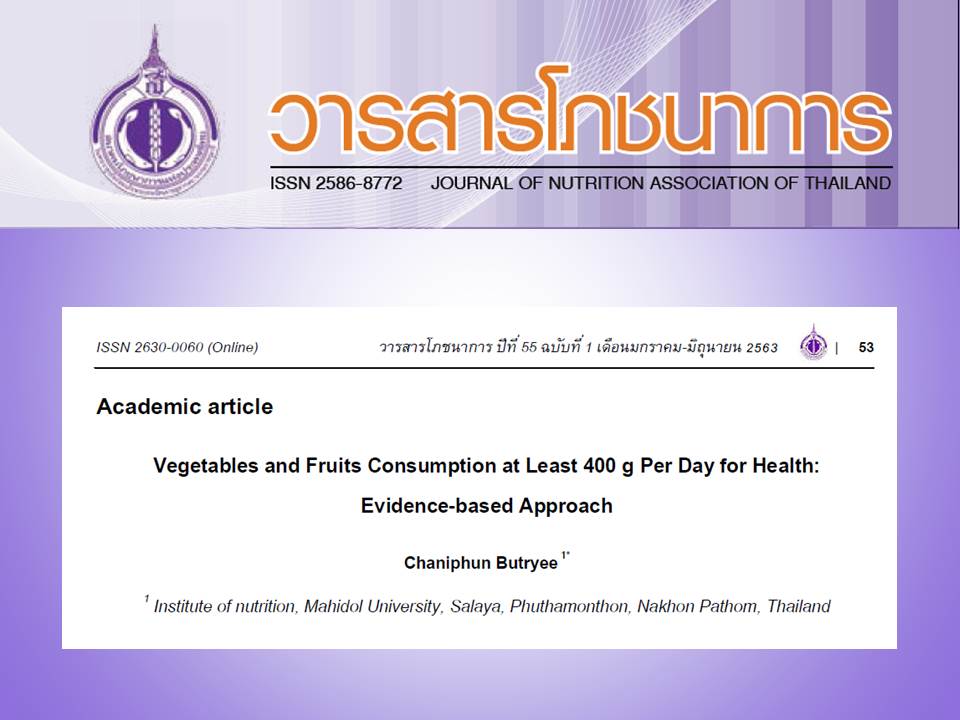Vegetables and Fruits Consumption at Least 400 g Per Day for Health: Evidence-based Approach
Keywords:
vegetable, fruit, 400 gram, health, safetyAbstract
The FAO/WHO recommends intake of at least five portions or at least 400 g of vegetables and fruits daily for the prevention of non-communicable diseases, such as, heart diseases, cancer, diabetes and obesity. The recommendation was based on the evidence that vegetables and fruits are sources of nutrients and non-nutrient food constituents which contribute to the reduction in disease risks. This recommendation can be achieved by consuming at least 30 g of whole grain foods (eg. unrefined rice, wheat, oat, barley and rye) to ensure an adequate daily intake of >25 g dietary fibre. Evidence showed that increased vegetable and fruit consumption (excluding potatoes and other starchy tubers) up to 400-600 g/day reduced the burden of various diet-related chronic diseases (NCDs). For example, the reduction of risks of ischaemic heart disease and ischaemic stroke was 31% and 19% respectively. For stomach, lung and colorectal cancer, the potential reductions were 19%, 12% and 2%, respectively. Therefore, the objectives of this review were (1) to compile evidence from epidemiological studies focusing on prospective observational and intervention studies on risk reduction of specific foods on various NCDs; (2) to recommend possible menu planning and measures to ensure vegetables and fruits consumption at least 400 g per day; (3) to advice the way to reduce bacteria and pesticide residue contamination in raw produce. Practical menu planning to achieve at least 400 g/day of vegetable and fruit intakes from traditional Thai and fusion menus was suggested. To minimizing a range of microbial and chemical contaminants before consuming, various food safety measures (e.g., washed with water, chemical disinfectants, depending on the type of pesticides), to ensure that residue levels are below the established limits to safeguard human health. Off-season production may increase the risk of pesticide residues and should be avoided. Authorized agencies should conduct adequate monitoring programs, to assure that safe or tolerable levels of contaminants are not exceeded.
References
World Health Organization. Diet and nutrition in the prevention of chronic disease. Geneva: World Health Organization; 1990.
World Health Organization. Diet and nutrition in the prevention of chronic disease. Geneva: World Health Organization; 2003.
He K, Hu FB, Colditz GA, Manson JE, Willett WC, Liu S. Changes in intake of fruits and vegetables in relation to risk of obesity and weight gain among middle-aged women. Int J Obes Relat Metab Disord. 2004; 28:1569-74.
Hung HC, Joshipura KJ, Jiang R, Hu FB, Hunter D, Smith-Warner SA, et al. Fruit and vegetable intake and risk of major chronic disease. J Natl Cancer Inst. 2004; 96:1577–84.
He FJ, Nowson CA, MacGregor GA. Fruit and vegetable consumption and stroke: Meta-analysis of cohort studies. Lancet. 2006; 367:320-6.
Lock K, Pomerleau J, Causer L, Altmann DR, McKee M. The global burden of disease attributable to low consumption of fruit and vegetables: implications for the global strategy on diet. Bull World Health Organ. 2005; 83:100-8.
Boeing H, Bechthold A, Bub A, Ellinger S, Haller D, Kroke A, Leschik-Bonnet E, Müller MJ, Oberritter H, Schulze M, Stehle P, Watzl B. Critical review: vegetables and fruit in the prevention of chronic diseases. Eur J Nutr. 2012; 51: 637-63.
Maskarinec G, Chan CLY, Meng L, Frank AA, Cooney RV. Exploring the feasibility and effect of a high-fruit and -vegetable diet in healthy woman. Cancer Epidemiol Biomarkers Prev l. 1999; 8:919-24.
Lasheras C, Gonzalez S, Huerta JM, Lombardia C, Iban REZ, Patterson AM, et al. Food habits and associated with lipid peroxidation in an elderly population. J Am Diet Assoc. 2003; 103:1480-87.
World Cancer Research Fund/American Institute for Cancer Research. Continuous Update Project Expert Report. Diet, nutrition, physical activity and cancer: a global perspective. Washington DC: AICR; 2018. Available from: https://www.wcrf.org/dietandcancer
World Cancer Research Fund/American Institute for Cancer Research. Wholegrains, vegetables and fruit and the risk of cancer. Report on Continuous Update Project: Diet, nutrition, physical activity and the prevention of cancer. Washington DC: AICR; 2018. Accessed on 15 January 2019. Available from: https://www.wcrf.org/sites/default/files/Wholegrains-veg-and-fruit.pdf
วันทนีย์ เกรียงสินยศ. กินผักผลไม้ 400 กรัมเพื่อสุขภาพ: การประมวลองค์ความรู้จากการประชุมวิชาการกินผักผลไม้ปลอดภัย 400 กรัม เพื่อสุขภาพ. สมาคมโภชนาการแห่งประเทศไทย ในพระบรมราชูปถัมภ์สมเด็จพระเทพรัตนราชสุดาฯ. กรุงเทพมหานครฯ: บริษัทปัญญามิตรการพิมพ์ จำกัด; 2560.
ชนิพรรณ บุตรยี่. การเพิ่มการบริโภคพืช ผัก ผลไม้. คณะกรรมการขับเคลื่อนยุทธศาสตร์เพื่อสร้างความเชื่อมโยงด้านอาหารและโภชนาการสู่คุณภาพชีวิตที่ดีภายใต้การดำเนินงานของคณะกรรมการอาหารแห่งชาติ. กรุงเทพฯ : โรงพิมพ์องค์การสงเคราะห์ทหารผ่านศึกในพระบรมราชูปถัมภ์; 2555.
สำนักโภชนาการ กรมอนามัย. เมนูแนะนำวันนี้ กินเค็มน้อยลงสักนิด พิชิตโรคความดันฯ. กรุงเทพฯ: ศูนย์สื่อและสิ่งพิมพ์เเก้วเจ้าจอม; 2555.
กรมอนามัย กระทรวงสาธารณสุข. คุณค่าทางโภชนาการในผลไม้. กรุงเทพฯ: โรงพิมพ์ชุมนุมสหกรณ์การเกษตรแห่งประเทศไทย จำกัด; 2553.
รุ่งรัตน์ แจ่มจันทร์ และ ริญ เจริญศิริ. 50 เมนูอาหารลดน้ำหนัก. กรุงเทพฯ : สำนักพิมพ์สารคดี; 2558.
ชนิพรรณ บุตรยี่. รังสรรค์เมนูฟิวชั่นด้วยผัก ผลไม้ 100 กรัม. นครปฐม: สถาบันโภชนาการ มหาวิทยาลัย มหิดล; 2561. (เข้าถึงเมื่อ 15 มกราคม 2563) เข้าถึงได้จาก https://www.inmu.mahidol.ac.th/th/free_book.htm
Wu J, Luan T, Lan C, Hung Lo TW, GYS. Removal of residue pesticides on vegetables using ozonated water. Food Control. 2007a; 18(5):466-472.
Wanwimolruk S, Kanchanamayoon O, Phopin K, Prachayasittikul. Food Safety in Thailand 2: pesticide residues found in Chinese kale (Brassica oleracea), a commonly consumed vegetable in Asian countries. Sci Total Environ. 2015b; 532:447–455.
วนิดา จันทร์สม. การศึกษาเปรียบเทียบวิธีการล้างผักกะหล่ำปลีและผักกาดขาวเพื่อลดปริมาณสารพิษตกค้างกลุ่มไพรีทรอยด์.ธรรมศาสตร์เวชสาร 2556;13(1):71-78.
อัจฉรา แสนคม, ธรรมศักดิ์ ทองเกตุ และ วราภา มหากาญจนกุล. การประยุกต์ใช้สารฆ่าเชื้อกลุ่มออกซิไดส์ซิ่งเพื่อลดการตกค้างของยาฆ่าแมลงในผักสด.วารสารวิทยาศาสตร์เกษตร 2554; 3/1(Suppl.):447-450.
Schreinemacher P, Wu MH, Uddin N, Ahmad S, Hanson P. Farmer training in off-season vegetables: Effects on income and pesticide use in Bangladesh. Food Policy. 2016; 61:132-140.
Lemon Farm Organic Family Food. ปลูกกินตามฤดูกาล ฤดูไหนก็ไกลโรค. หน่วยงานเอกชน; 2563 (เข้าถึงเมื่อ 15 มกราคม 2563) เข้าถึงได้จาก https://www.lemonfarm.com/?page_id=3049
ภัสน์วจี ศรีสุวรรณ์. สุขภาพดูแลเองได้-มากินผักหน้าฝนกันเถอะ.ปฏิทินผักและผลไม้.นิตยสารสารคดี 2553;25(307) (เข้าถึงเมื่อ 15 มกราคม 2563) เข้าถึงได้จาก https://www.sarakadee.com/2011/03/03/rainyveggie/

Downloads
Published
How to Cite
Issue
Section
License
Upon acceptance of an article, copyright is belonging to the Nutrition Association of Thailand.


